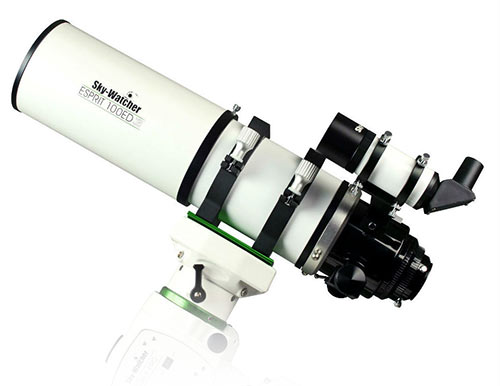The Tulip Nebula
The Tulip Nebula is a glowing cloud of interstellar gas and dust in the constellation Cygnus. This emission nebula is cataloged as Sharpless 101, or Sharpless Sh2-101. The Tulip Nebula is about 8,000 light-years from Earth, and 70 light-years across in size.
I captured the photo below using a dedicated astronomy camera attached to a refractor telescope. To create this detailed photo of the Tulip Nebula, I recorded images in 3 separate wavelengths of light.
The photo displays the intense areas of gas emitted by this emission nebula in Cygnus. The Hubble Palette was used to map each of the prominent gases to RGB color channels.
The Tulip Nebula in Cygnus. 3.5 Hour Exposure.
The field of view for this image is 1.1 x 1.37 degrees (radius 0.877 deg.) with an image scale of 6.57 arcsec/pixel. The camera used was a ZWO ASI2600MM Pro, a monochrome CMOS dedicated astronomy camera.
Tulip Nebula Details:
- Common Name: Tulip Nebula
- Cataloged: Sharpless 101, Sh2-101
- Object Type: H II Region (Emission Nebula)
- Apparent Magnitude: 9.0
- Apparent Dimensions: 16′ x 9′
- Constellation: Cygnus
In 2022, I captured a new version of the Tulip Nebula using a larger telescope for a closer view. This image was taken using a Sky-Watcher Esprit 150 Apochromatic Triplet at a focal length of 1050mm.
My latest photo of the Tulip Nebula.
The Tulip Nebula gets its name from the flower it appears to resemble when photographed. This nebula was cataloged by American astronomer Stewart Sharpless in 1959.
An interesting feature of the Tulip Nebula is its close proximity (from our vantage point on Earth) to the galactic X-ray source known as Cygnus X-1. Cygnus X-1 is one of the strongest X-ray sources seen from Earth and is the site of one of the first suspected black holes.
Cygnus X-1 is thought to be a stellar-mass black hole, a class of black holes created by the collapse of a massive star.

The location of Cygnus X-1 (Stellar Mass Black Hole).
About the Image
I used narrowband filters (Chroma 3nm Ha, OIII, and SII) to photograph the Tulip Nebula in different wavelengths of light to create a full-color image. Here is an example of this region in H-alpha using a narrowband filter.

The Tulip Nebula in H-Alpha (ZWO ASI2600MM Pro + Chroma 3nm Ha).
The telescope used to photograph the Tulip Nebula in high resolution is a Sky-Watcher Esprit 100 ED APO. This is a premium apochromatic refractor telescope with a focal length of 550mm at F/6.
For a complete list of telescopes I recommend for space photography, be sure to check out my article on the best astrophotography telescopes for beginners.
Sky-Watcher Esprit 100 ED Super APO.
My final image includes 3 hours and 30 minutes total exposure time. The images were registered and stacked using DeepSkyStacker, utilizing dark frames and flat frames for calibration.
To automate the imaging sequence, I used Astro Photography Tool to collect each 5-minute exposure, with dithering between each frame. Autoguiding was done via PHD2 Guiding, through a 60mm guide scope and ZWO ASI290MM Mini camera.
In the image below, you can see the camera and telescope mounted to my Sky-Watcher EQ8-R Pro equatorial telescope mount in the backyard.

My deep-sky astrophotography setup in the backyard.
The Tulip Nebula in Cygnus
The Tulip Nebula can be easy to ignore in the busy constellation of Cygnus. Several emission nebula targets populate this region, including the dramatic Crescent Nebula nearby (about 2 degrees southwest).
The star responsible for much of the Tulip Nebula is HDE 227018, which can be seen near the center of the nebula. A wide-field apochromatic refractor telescope is a fantastic choice if you like photographic large nebulae regions like the one above.

The field of view you can expect will depend on the sensor of your imaging camera, and the focal length of your telescope. In the case of my crop-sensor ZWO ASI2600MM Pro camera, the field of view includes the Tulip Nebula and much of the surrounding nebulae regions.
You can use the Stellarium planetarium software to identify the exact field of view you will get with a particular camera and telescope configuration. This is very useful when planning your next deep sky astrophotography project.
Where is the Tulip Nebula?
The Tulip Nebula is located in the constellation Cygnus. You can use the catalog number Sh2-101 (Sharpless 101) to identify its location using a star map or by searching for it using a stargazing app on your smartphone.
From mid-northern latitudes, you’ll find the Tulip Nebula rising in the east just after dark by late May. The Tulip Nebula reaches an adequate apparent altitude for astrophotography (30°) just after midnight.
If your GoTo telescope mount does not include the Sharpless catalog in its object database, entering in the NGC 6871 will get you very close. From here, you can manually point your telescope towards the Tulip Nebula to center it.

In the wide-angle image of the Cygnus region and Summer Triangle below, I have identified the location of the Tulip Nebula. As you can see, it resides on the far side of the constellation Cygnus, well past the larger, more common deep-sky objects in the constellation.
The massive North America Nebula, Pelican Nebula, and Butterfly Nebula usually capture the attention of backyard astrophotographers, but the Tulip Nebula is certainly worthy of your time as well. I hope that this post has inspired you to take a closer look at this photogenic nebula in Cygnus.
New to astrophotography? Find out the equipment I use, the processes involved, and how to get started.




